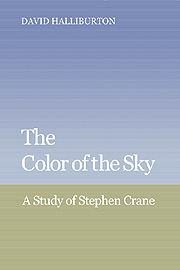Book contents
- Frontmatter
- Contents
- 1 Introduction
- 2 The Little: Early Writings
- 3 Conflict as Condition: Maggie: A Girl of the Streets
- 4 Doing Without: George's Mother
- 5 Eternal Fact and Mere Locality: The Red Badge of Courage: An Episode of the American Civil War
- 6 The Mysteries of Heroism and the Aesthetics of War: Army Tales and Other War Writings
- 7 Community and Crisis: “The Monster,” Tales of Whilomville, “The Blue Hotel,” “The Bride Comes to Yellow Sky”
- 8 The Ethics of Their Condition and the Unreal Real: “The Open Boat,” “The Five White Mice”
- 9 The Farther Shore: Poems
- Notes
- Index
2 - The Little: Early Writings
Published online by Cambridge University Press: 06 July 2010
- Frontmatter
- Contents
- 1 Introduction
- 2 The Little: Early Writings
- 3 Conflict as Condition: Maggie: A Girl of the Streets
- 4 Doing Without: George's Mother
- 5 Eternal Fact and Mere Locality: The Red Badge of Courage: An Episode of the American Civil War
- 6 The Mysteries of Heroism and the Aesthetics of War: Army Tales and Other War Writings
- 7 Community and Crisis: “The Monster,” Tales of Whilomville, “The Blue Hotel,” “The Bride Comes to Yellow Sky”
- 8 The Ethics of Their Condition and the Unreal Real: “The Open Boat,” “The Five White Mice”
- 9 The Farther Shore: Poems
- Notes
- Index
Summary
No one seems to have written a history of the little, or, for that matter, of the large. Given the authority and charisma associated with great size, the latter optic might seem the more obvious of the two. Vico's version of history is a case in point. According to The New Science (Book 2, Chapter 3), gentile humanity was founded by people who renounced the true religion of Noah and then, because of their hard life in the forests that sprang up after the Flood, grew to be giants. The Hebrews meanwhile retained a normal human size, to which the giants returned. Largeness remains a convenient way of figuring the paradigmatic and the powerful. The little has a history in its own right, however, and one of particular interest since at least as early as the Renaissance.
A LITTLE HISTORY
In the story of scale, the invention of the compound microscope in 1590 and the telescope in 1605 are important landmarks.
One invention increased the scope of the macrocosm; the other revealed the microcosm: between them, the naive conceptions of space that the ordinary man carried around were completely upset: one might say that these two inventions, in terms of the new perspective, extended the vanishing point toward infinity and increased almost infinitely the plane of the foreground from which those lines had their point of origin.
- Type
- Chapter
- Information
- The Color of the SkyA Study of Stephen Crane, pp. 15 - 37Publisher: Cambridge University PressPrint publication year: 1989



